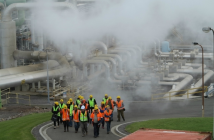Minimising downtime, ensuring quality and providing maximum safety for employees are particularly important in food and beverage production, processing and automation, writes Andreas Bauer
In the food and beverage industry, if the processing of perishable foodstuffs ceases it not only leads to profit losses, but also high costs from waste disposal and recommencing production.
Another extremely important factor for the industry is quality – if the quality is inadequate, consumers are not only dissatisfied, they are also at risk of developing health problems.
One of the crucial factors is regular cleaning of production facilities: when the cleaning crews use steam jets and acidic or alkaline cleaning agents to remove dirt and germs, the systems are subjected to high levels of strain.
Another considerable burden is the common process of dry cleaning with aggressive cleaning agents or dry ice – which is a rather new trend.
Therefore, all production and automation components need to be designed in a way that makes them permanently sealed and functional, while being made from shapes and materials which do not provide a breeding ground for germs.
Three hygiene zones
The first requirement, though, is always to select and use the right components. Industrial work groups such as the globally respected “Safe Food Factory,” which aims to act as an international platform that brings together industry, standards and practice, has compiled recommendations for this.
Prior to being published, the new standard was checked by a commission of representatives from potential user companies such as BAT, Jacobs Douwe Egberts, Nestlé and Unilever.
While hygiene is always important, the extent of its importance rises further in some critical areas.
The closer a component comes to foodstuffs, the higher the requirements.
Three types of hygiene zones are generally distinguished:
- Product zone: these regularly come into contact with foodstuffs. Examples include stirrers, filling nozzles, blades and cutters.
- Spray zone: these are areas and machines which come into contact with foodstuffs, for example through spraying. Generally, a surveyor or the producer conducts a risk assessment to determine whether the food can return to the product zone.
- Non-product zone: these include all areas and facilities in a factory which do not come into direct contact with the foodstuffs. However, these areas are often cleaned together with the more sensitive areas, which in turn may result in high chemical and mechanical stresses.
Stringent hygiene requirements apply in the spray and product zones, which need to be cleaned particularly frequently and thoroughly.
This is generally the responsibility of the cleaning crews, who work at piece rates and use strong cleaning agents such as corrosive acids and alkalis in different concentrations – or they may clean surfaces by wiping them dry, or they might use hot steam jets.
A relatively new trend is dry-ice-cleaning, which is an alternative for those who want to work without aggressive cleaning agents.
Dry-ice particles -78°C cold, are blasted onto heavily soiled surfaces such as tanks, boilers, or ovens, at pressures between two and 6 bar.
Dirt freezes and gets brittle, which makes it easy to remove.
Few materials are able to withstand all of these various strains in the long term, the main one being stainless steel, which is used most of all in the product zone, where it is virtually the only material used.
Plastics and other materials which are frequently used for cables or seals of components present some particularly tough challenges.
If plastics or elastomers are used when they are not suitable for frequent cleaning, there is a danger that, for instance, some system parts will lose their protection rating, or a cable will lose its insulation properties.
An extreme example is provided by a bakery where outgassing from the dough had caused a cable sheath to swell and become brittle.
The employees were therefore in acute danger, because there was the risk of short circuiting and electric shocks.
The quality of the products was also jeopardised because the plastic could have fallen into the dough.
Beyond this, another one of the main challenges is the installation type: cables are often bundled more tightly together than they ought to be, or they are not easily accessible.
Loose cabling with a bit of ‘play’ would be ideal for easy cleaning.
However, technical inspectors normally place great importance on the use of fixed installation – a happy medium needs to be found.
Safe Food Factory participants recognised that overly long cables represent a problem: cables are often installed with some excess length so that there is a reserve.
While this is a comfortable approach, it is also problematic, firstly in terms of electrical engineering (keyword bundling) and secondly because the loops that form are often tough to clean and dirt gets trapped in them.
The participants generally established that the cables should ideally be installed in such a way that they are as far away as possible from the intensive cleaning processes.
Additionally, hybrid cables can be used.
If several cables are combined into one, there is then is less cable space and less intermediate space in which impurities can accumulate.
The Safe Food Factory recognised a further challenge involving contradictory requirements in major markets such as the US: on the one hand, companies wishing to export to the US face the National Fire Protection Association (NFPA) requirements for maximum fire protection.
On the other hand, the Food and Drug Administration (FDA) is critical of cables with reduced flame-propagation since some fire-retardant additives are prone to outgassing and can therefore contaminate raw materials.
This too needs to be weighed up on an individual basis.
Individual applications count
If cables are installed in the product zone (for example for a temperature or level sensor in a fermenter) they need to be particularly well protected, such as by installing them either in stainless-steel pipes, or in protective conduits, which can be far more cost-effective.
There is a further complication for applications with large temperature fluctuations, as condensation can form and collect in the protective conduit – this too is unhygienic in the long term.
In this case, the better option is to use an openly installed and highly durable cable in connection with an appropriate cable gland which follows the principles of hygienic design.
Such examples highlight the fact that there is no universally applicable best solution – each case needs to be individually assessed, and the application consultants at global cabling authorities such as Lapp help customers to find the best solution.
For end users, it is crucial to also consider the interaction between components.
It is therefore advisable to choose a supplier that can offer competent counselling about all aspects of connection technology and a very broad portfolio of connection solutions, including cables, connectors and accessories which fulfil the requirements of hygienic design.
Production facilities which are constructed according to the principles of Hygienic Design represent a huge step forward in terms of optimising quality, safety and ultimately efficiency in the food and beverage industry.
They are constructed in such a way that they do not allow germs to settle and can be cleaned easily.
They are also particularly robust.
No germs allowed
The Lapp products that meet the particularly stringent requirements of Hygienic Design include, for instance, the cable gland SKINTOP HYGIENIC.
It follows the general design principles of DIN EN 1672-2 for the food and beverage industry and is certified according to the latest EHEDG testing.
Furthermore, the cable entry – just like the cable conduit SILVYN FG NM and the ÖLFLEX ROBUST cable – meets the ECOLAB requirements relating to resistance to cleaning agents and disinfectants.
SKINTOP HYGIENIC does not provide any surfaces for contaminants to attack. All seals are fixed tightly to the cable and connection point with no gaps.
Instead of an O-ring, it has a radial moulded seal above the connection thread, a sealing ring below the domed cap nut and a specially formed conduit sealing ring on the cable.
It has smooth surfaces and no edges, meaning that remaining food cannot settle there and can easily be washed off.
The cable gland, as well as the SILVYN FG NM protective conduit, or the ÖLFLEX ROBUST cables also fulfil the ECOLAB requirements for durability against widely used cleaning agents.
In terms of product development, there is no need at all to keep reinventing the wheel: a pragmatic approach makes sense.
This means that often it is not necessary to develop expensive special products; instead existing products from mechanical and plant engineering ranges can often be used in the food industry as well.
One example of this is the classic “ÖLFLEX Robust”, a series of cables that resist both machine oil in industrial production and cleaning agents in food production.
This also applies for a wide selection of accessories and other cables with sheaths made from PVC, TPE, or PUR, some of which have undergone ECOLAB testing.
It is especially important for the end-user to know the exact requirements of the application in question and select adequate solutions.
Good, comprehensive counselling by experts who know the industry is extremely valuable here.
With its cables, connectors and accessories, Lapp also provides an extensive product portfolio which meets these requirements and is increasingly in demand in the food industry.
A feature that distinguishes Lapp from many other suppliers: as a manufacturer of all required cable technology components, Lapp is the only supplier with all the necessary knowledge.
Blue for protection
When installing cables in the product and spray zones, one alternative to using rigid and expensive stainless-steel pipes is using SILVYN FG NM, a flexible and dimensionally stable protective conduit made from soft PVC with an internal spiral, along with the accompanying conduit gland SILVYN HYGIENIC.
Both are suitable for contact with foodstuffs – and thus for use in the product zone – and are easy to clean.
The conduit, for instance, has no grooves in which residue can settle, unlike conduits used in mechanical engineering.
It is blue, as the sector requires it to be.
If a piece of plastic were to somehow fall into the food, it would be easier detect it this way, because in nature there are no materials with such an intense blue colour.
This is also the case for the cable ties, which Lapp provides especially for the food industry.
They are blue as well and also contain an admixture of metal.
This means that a missing cable tie can be retrieved very easily using a metal detector or an X-ray unit.
Special cabling solutions for the food and beverage industry are now already helping to increase productivity, safety and quality in the sector.
The Lapp Group’s newly developed and newly qualified portfolio for the food and beverage industry is being further expanded according to customer requirements.
Since some of the requirements of the pharma industry are comparable in terms of mechanical design, further applications are emerging here.
Lapp Australia has strong inventory of over 1,000 Lapp product lines onshore as well as direct access to more than 40,000 standard items from Lapp’s global ranges.
Andreas Bauer is Head of Product Management System Products for the global Lapp organisation, which seeks to meet demand for technologies used in future-focussed areas of industry, such as automation, robotics, energy management, data distribution and intelligent manufacturing, buildings, infrastructure and process engineering




